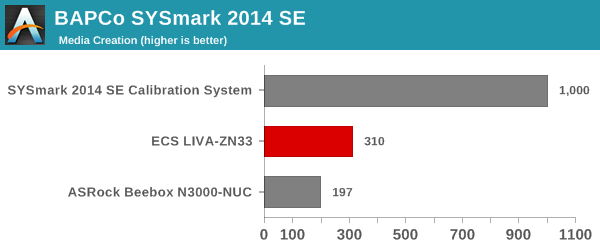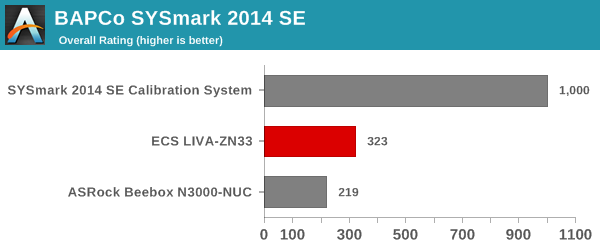ECS LIVA Z Fanless Dual-LAN Apollo Lake UCFF PC Review
by Ganesh T S on March 30, 2017 8:00 AM ESTPerformance Metrics - I
The ECS LIVA-ZN33 was evaluated using our standard test suite for low power desktops / industrial PCs. Not all benchmarks were processed on all the machines due to updates in our testing procedures. Therefore, the list of PCs in each graph might not be the same. In the first section, we will be looking at SYSmark 2014 SE, as well as some of the Futuremark benchmarks.
BAPCo SYSmark 2014 SE
BAPCo's SYSmark 2014 SE is an application-based benchmark that uses real-world applications to replay usage patterns of business users in the areas of office productivity, media creation and data/financial analysis. In addition, it also addresses the responsiveness aspect which deals with user experience as related to application and file launches, multi-tasking etc. Scores are meant to be compared against a reference desktop (the SYSmark 2014 SE calibration system in the graphs below). While the SYSmark 2014 benchmark used a Haswell-based desktop configuration, the SYSmark 2014 SE makes the move to a Lenovo ThinkCenter M800 (Intel Core i3-6100, 4GB RAM and a 256GB SATA SSD). The calibration system scores 1000 in each of the scenarios. A score of, say, 2000, would imply that the system under test is twice as fast as the reference system.





SYSmark 2014 SE also adds energy measurement to the mix. Unfortunately, we were unable to get the power logging working with either the ECS LIVA Z or the ASRock Beebox N3000-NUC.
The scores are what one would expect from an Atom-class CPU. On the performance per dollar front, systems like the ECS LIVA Z may turn out to be the right choice (particulary if the workloads are not time-critical). In any case, we do see a definite improvement in the Apollo Lake Celeron N3350-based ECS LIVA Z over the Braswell Celeron N3000-based ASRock Beebox N3000-NUC. Note, however, that the Intel Celeron N3000 has a 4W TDP, while the N3350 has a 6W TDP.
Futuremark PCMark 8
PCMark 8 provides various usage scenarios (home, creative and work) and offers ways to benchmark both baseline (CPU-only) as well as OpenCL accelerated (CPU + GPU) performance. We benchmarked select PCs for the OpenCL accelerated performance in all three usage scenarios. These scores are heavily influenced by the CPU in the system. Amongst the considered fanless PCs, the ECS LIVA Z is bettered only by the CompuLab fitlet-XA10-LAN which is configured with a much higher TDP (thanks to its efficient thermal design).



Miscellaneous Futuremark Benchmarks





3D Rendering - CINEBENCH R15
We have moved on from R11.5 to R15 for 3D rendering evaluation. CINEBENCH R15 provides three benchmark modes - OpenGL, single threaded and multi-threaded. Evaluation of select PCs in all three modes provided us the following results.



The Celeron N3350 in the ECS LIVA Z does win the single-threaded case. However, its dual-core configuration loses out to the quad-core Celeron N2930-based Zotac CI320 nano in the multi-threaded workload. In the OpenGL case, the higher base frequency (320 MHz vs. 200 MHz) helps the Celeron N3050 in the LIVA x2 get a slight edge over the Celeron N3350 in the ECS LIVA Z.










30 Comments
View All Comments
Smudgeous - Thursday, March 30, 2017 - link
I concur. This beats the Fitlet in terms of price by around 50% (especially when you factor in the extended fin heatsink/cover) and the power draw in the 3450 would still be better for comparable performance. This little guy looks like a real gem.Namisecond - Monday, April 3, 2017 - link
What you save, you lose in capability. The Fitlet models offer up to 4 additional PCIe ethernet ports, Intel i211 IIRC. The Fitlet also seems more purpose-built as a hobbyist network appliance. The Liva Z are more like thin clients where they made an error and stuck on another ethernet port. There are plenty of Bay Trail based network appliance boxes you can pick up on amazon and ebay that come in under the Liva Z's price point, many of them even offer 4 Intel ethernet ports.jaydee - Thursday, March 30, 2017 - link
Because obviously we all know you were commenting a different model than the one reviewed here, without mentioning it...nathanddrews - Friday, March 31, 2017 - link
IKR?Holliday75 - Friday, March 31, 2017 - link
Lets just start leaving random review comments in other articles and then berating people who not knowing what product we are talking about.JoeyJoJo123 - Friday, March 31, 2017 - link
>The LIVA Z comes in three variants,corresponding to the three members of the Apollo Lake mobile SoC family (6W TDP) - the Pentium N4200, or the _Celeron N3450_, or the Celeron N3350. Our review sample, the LIVA-ZN33 is based on the Intel Celeron N3350.If I were state that "it's great that this phone can be equipped with 128GB of storage" in a review about a Samsung Galaxy phone, where in particular the 64GB model was reviewed, my comment would still be
1) Relevant.
2) Obvious given that all electronics products get launched with different configurations.
Responding back that "Hey, this phone has 64GB of storage" is neither enlightening nor relevant to someone commenting that a product can be equipped with 128GB of storage if one chooses to purchase that particular SKU.
The proper way to respond back if you didn't realize that would be "Oh, gotcha!" or "Yeah, that's an interesting point!" rather than pushing the blame back to me, as if I'm somehow at any fault of you not understanding that there are different SKUs of this particular model available.
extide - Tuesday, April 11, 2017 - link
And it even supports AES-NI -- which I rely on because I make very heavy use of OpenVPN. I have been able to saturate my 300Mbit connection on a reasonably slow processor (albeit faster than this) with AES-NI -- I doubt I would even get close without it -- especially on an Atom.mckirkus - Friday, March 31, 2017 - link
Torn between this and an Asrock dual Intel LAN mini-itx build with a low power i3. The i3 will get you hardware encryption but it's probably ridiculous overkill for most.huhn - Thursday, March 30, 2017 - link
what's the point of the refresh rate test?i know intel was using the wrong math for 23p years ago but that doesn't mean a perfect 24 hz for 24p is any good.
the display refreshrate in madVR is calculated from the system clock and the GPU clock (pretty obvious that it is using the same clock generator for both) but that not important for perfect playback.
for perfect playback a GPU clock that is close to the audio clock is needed without frame drops or repeats and this look pretty bad on this system. 16 mins is not good at all.
the clock deviation is relative high and the drop/repeat every X mins is pretty low on the screen screen.
for better judgment a video should be played for 10 min+ and the audio volume should be changed at the start of playback a couple of times to see the real drop/repeat frame every X sec/mins/hours/days.
the used audio device can play a huge roll in this too.
but what so ever i don't see any gain from the reported refresh rate it a very unimportant number.
SquarePeg - Thursday, March 30, 2017 - link
Everything about the $180 model just screams "Chromebox".